中国南方五峰组—龙马溪组页岩中笔石与有机质富集关系探讨
2016-12-23董大忠施振生王红岩张晨晨刘德勋
邱 振 董大忠 卢 斌 周 杰 施振生 王红岩 吝 文 张晨晨 刘德勋
(1.中国石油勘探开发研究院 北京 100083;2.中国石油勘探开发研究院廊坊分院 河北廊坊 065007)
中国南方五峰组—龙马溪组页岩中笔石与有机质富集关系探讨
邱 振1,2董大忠1,2卢 斌2周 杰2施振生2王红岩2吝 文2张晨晨1刘德勋2
(1.中国石油勘探开发研究院 北京 100083;2.中国石油勘探开发研究院廊坊分院 河北廊坊 065007)
中国南方奥陶纪—志留纪之交广泛沉积了以五峰组和龙马溪组为代表的笔石页岩。基于对重庆巫溪地区五峰组—龙马溪组底部页岩段中近400件页岩样品中笔石丰度的统计及100件页岩样品有机碳含量(TOC,%)的分析测试结果,选择其中23件不同笔石丰度与TOC的页岩样品开展页岩中笔石体与围岩(非笔石体部分)TOC的对比实验,并结合能谱分析测试结果,探讨笔石与有机质富集的关系。初步研究认为:①五峰组—龙马溪组页岩中笔石体的C、O等元素含量较高,其TOC明显高于围岩,是页岩有机质的贡献者之一;②五峰组—龙马溪组页岩全岩TOC与笔石丰度及笔石体TOC相关性均较差,而与围岩TOC相关性较好,这指示着页岩中笔石丰度对有机质富集影响较小。
笔石 页岩气 五峰组 龙马溪组 有机质富集 巫溪地区
0 引言
我国华南奥陶纪—志留纪之交广泛沉积了以五峰组和龙马溪组为代表的笔石页岩[1-3](图1),是我国页岩气勘探开发的重点层系[4-7]。目前已在该层系发现了威远、长宁、焦石坝3个页岩气田,并形成了富顺—永川、彭水等页岩气产气区[8-11],探明地质储量已超5千亿方[10],资源潜力巨大。近些年来,勘探家们开始重视五峰组—龙马溪组页岩气富集机理及主控因素研究,普遍认为五峰组—龙马溪组富有机质页岩是页岩气富集的物质基础[9-10,12]。特别是五峰组—龙马溪组底部的富笔石页岩,有机碳含量(TOC,%)一般高于2%,最高达8%以上[10],且TOC与含气量具有较好的正相关关系[13],是目前页岩气勘探开发的目标层段[8]。因此,前人对这段笔石页岩开展了大量基础研究,主要包括古生物及地层学[2,14-16]、岩石学[17-19]、沉积储层[20-23]、地球化学[24-29]等方面,均取得了重要成果与认识。与此同时,一些学者对五峰组—龙马溪组笔石页岩中有机质富集主控因素进行了探讨,总体上认为缺氧保存条件是有机质富集的主控因素[10,24-30]。但作为五峰组—龙马溪组页岩中的重要组成部分——笔石生物,对页岩中有机质贡献多少或者与有机质富集的关系等方面的研究相对较少。
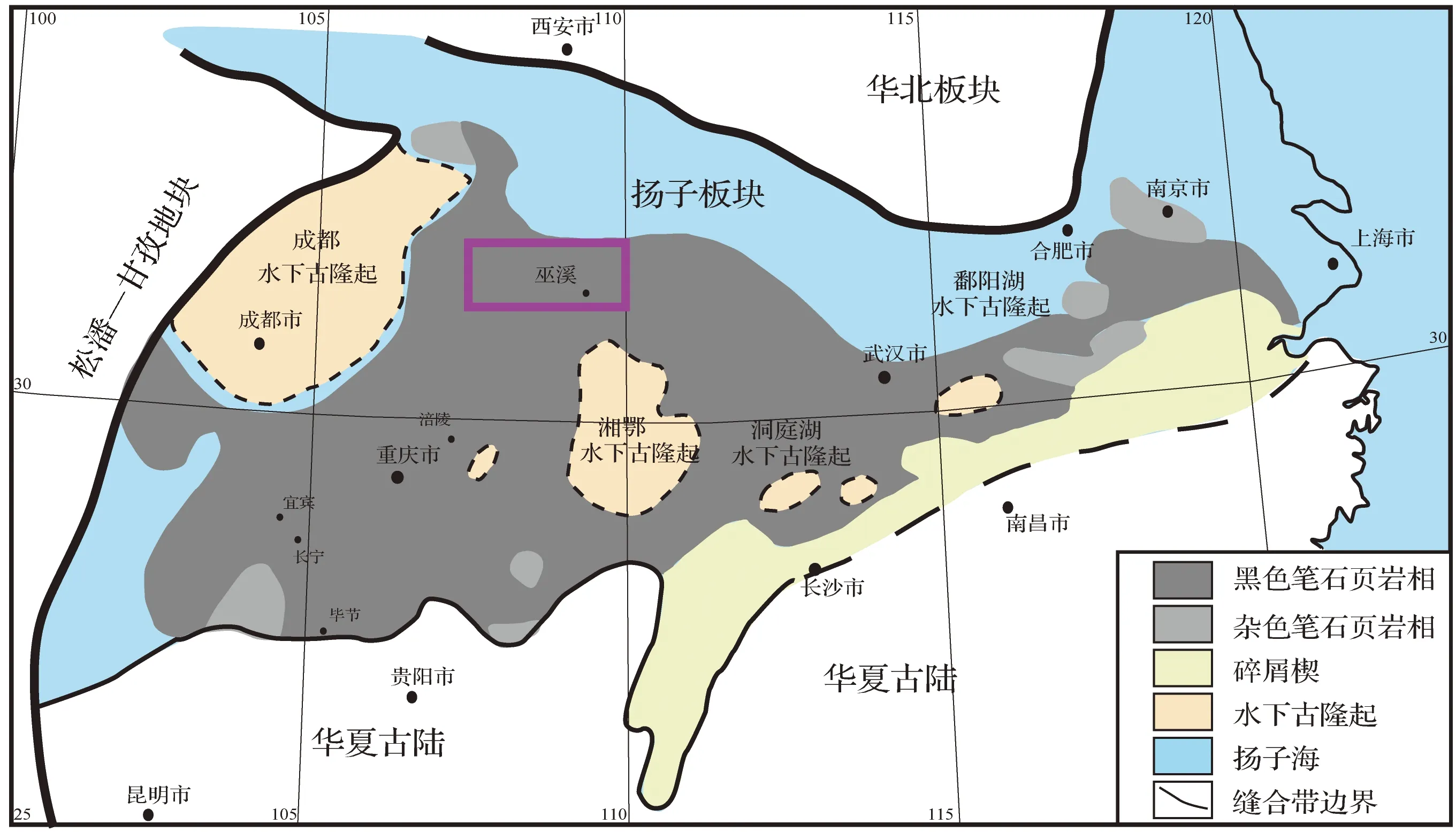
图1 中国南方志留系鲁丹早期龙马溪组黑色页岩分布(修改自Chen, et al.[1]和樊隽轩等[2])及研究区位置(粉红色框:重庆巫溪地区)Fig.1 The distribution of early Rhuddanian Longmaxi shale in South China (modified from Chen, et al.[1] and Fan, et al.[2] ) and location of the study area (red rectangle: Wuxi, Chongqing)
1 地质背景与样品采集
五峰组—龙马溪组黑色笔石页岩在我国南方地区广泛发育(图1),前人已对该地区黑色笔石页岩的分布特征开展了大量研究[1-3,40-42]。研究表明,五峰期黑色硅质和碳质笔石页岩发育于扬子地台的大部分区域[1],扬子地区五峰组与龙马溪组黑色笔石页岩岩相均表现为浅水(陆棚海)、盆地型(扬子型)[40]。其中,五峰组黑色笔石页岩以含碳粉砂岩、粉砂质泥岩为主,局部发育硅质岩,沉积构造以毫米级纹层为主,且发育有分散状的黄铁矿晶体,厚度为3~40 m,含有大量笔石,超过30个以上的属,主要分布在四川、滇东、贵州、湖北、湘西北等整个扬子地台区[40]。早鲁丹期,黑色硅质笔石页岩在整个扬子地台上广泛分布[1]。龙马溪组黑色笔石页岩岩性以黑色含碳粉砂岩、泥岩为主,沉积范围小于五峰期,且其沉积厚度及岩相在横向上表现出规律性变化。在上扬子陆架—海盆内,黑色笔石页岩厚度由黔中古陆向西北方向逐渐增厚,从30多米增大到700多米[43],水平纹层发育[40],笔石种类丰富,跨越了从奥陶系顶部到志留系兰多维列统的10个笔石带[2]。扬子地区龙马溪期具有与五峰期相同的滞流陆架—盆地环境,而在赣西北和湘中地区由陆架相逐渐变为斜坡相。早志留世后期,随着湘中、赣北及扬子地区等地上升,海水逐渐变浅,扬子地台也全部转变为正常浅海环境[40]。
研究区为我国南方重庆巫溪地区,位于扬子台地北缘(图1)。该区五峰组—龙马溪组笔石页岩段相对较厚,局部可达90 m,TOC平均为2.5%[44],岩性主要为黑色碳质泥页岩、硅质页岩等[45-46]。样品主要来自该区钻井岩芯的五峰组—龙马溪组底部笔石页岩段,总厚度约44 m,共采集100余件样品。样品分布范围包括五峰组、龙马溪组底部(笔石带Normalograptus Persculptus 至Lituigraptus convolutus)(图2)。
2 研究方法
首先,基于钻井岩芯观察,详细统计了五峰组—龙马溪组底部页岩段中近400块页岩层面上的笔石丰度。同时,自下而上,采集了100余件页岩样品,进行TOC分析测试。其次,在此基础上,选择其中19件不同笔石丰度与TOC的页岩样品,分别开展页岩中笔石体与围岩的TOC分析测试。同时,考虑到页岩中笔石体分布具有强烈的非均一性,选择8件页岩样品(其中4件为新加样品)开展笔石体、围岩(非笔石体部分)及全岩(即笔石体分布纹层,仅包括笔石体和围岩)TOC的分析测试。这些是通过牙钻对页岩层面上的笔石体及无笔石岩石进行微区取样实现的,在这一过程中尽量保证微区样品的纯度,特别是笔石体的纯度,尽量减小围岩的污染。有机碳含量测定在美国生产的LECO碳硫分析仪CS230上完成。实验步骤如下:①装样:称取50~100 mg样品装入经过高温烘干过的透水坩埚中;②泡样:将浓盐酸与去离子水按1:7的比例稀释,把装有样品的透水坩埚浸泡在稀盐酸中,并进行水浴加热(60℃)两小时;③洗样:利用去离子水将透水坩埚中样品的盐酸洗去,直到变成中性;④烘样:将透水坩埚置于烘干箱中(80℃)烘干两小时;⑤测试:将样品上机进行测试,记录实验数据。

图2 重庆巫溪地区XX钻井五峰组—龙马溪组底部页岩TOC与笔石含量分布Fig.2 Graptolite abundance and TOC of the Wufeng and Longmaxi shales from XX borehole in Wuxi area, Chongqing
为了进一步详细对比笔石体与围岩的C等元素差异,选择了4件龙马溪组页岩样品进行能谱测试。采用配置有电子背散射衍射(EBSD)和能谱成分测试(EDS)的聚焦粒子束双束扫描电镜FIB(Nova 200 NanoLab)对页岩样品中笔石体与围岩分别进行元素相对原子比测试,探测灵敏度为原子摩尔分数0.1%~1.0%。4件测试样品中共测试96个点,其中笔石体和围岩各占一半。
3 分析结果与讨论
3.1 分析结果
五峰组—龙马溪组底部页岩TOC变化较大,为0.3%~6.8%,平均值4.6%,整体上属于富有机质页岩(图2)。其中五峰组页岩TOC变化较大,为0.3%~6.4%,平均值3.7%;龙马溪组底部页岩为3.5%~6.8%,平均值5.1%,明显高于五峰组。五峰组—龙马溪组底部页岩笔石丰度变化也较大(图3),一般为低于20%,高者可达80%(图2)。其中五峰组页岩笔石丰度整体偏低,低于10%,而在龙马溪组底部则相对较高。
19件不同笔石丰度与TOC的页岩样品的笔石体与围岩TOC对比分析结果如表1所示。不同页岩中笔石体的TOC相对较高,为3.6%~9.7%,明显高于围岩及页岩全岩的TOC(图4)。页岩全岩与围岩的TOC相近,分别为3.2%~6.2%和3.0%~7.1%(图4)。
五峰组—龙马溪组底部页岩能谱分析测试结果如图4所示,C、O、Si和Al四种元素是笔石体和围岩的主要组成元素,其中C、O和Si含量相对较高,并存在一定差异。K、Na、S、Fe、Mg等元素含量明显偏低,且差异相对较小。
3.2 页岩中笔石与有机质富集关系探讨
⑤从排沙角度,长江流域的雅砻江、金沙江、青衣江、嘉陵江、涪江、渠江、汉江的丹江口以上属于多沙区,而金沙江和雅砻江的源头、岷江、乌江、洞庭湖水系、鄱阳湖水系为少沙区,在其他条件相同的情况下,少沙区水库蓄水时间可以适当提前,而多沙区水库蓄水应该滞后。
笔石作为一类已经绝灭的海生群体动物,保存下来的仅是笔石虫体所分泌的骨骼即笔石体[47]。国内外一些学者对含笔石页岩相关研究结果均表明:笔石是页岩中有机质的组成部分之一[37-39,48-49]。笔石被认为对有机质有贡献主要是基于笔石体成分的研究,一些学者认为笔石体主要由C元素组成[37-38],可能是由含O、N等杂原子基团的高分子化合物的聚合物蛋白质组成[38]。4件龙马溪组笔石页岩样品能谱测试分析结果(图5)表明:C、O、Si和Al四种元素是笔石体的主要组成元素,其中C、和O相对含量最高,指示着笔石体主要由C、O等有机质元素组成。19件不同笔石丰度与TOC的页岩样品的笔石体与围岩TOC对比分析结果(图4)也表明:笔石体的TOC明显高于围岩及页岩全岩的TOC。这些特征均指示着笔石是页岩有机质的贡献者,但这是否可以说明五峰组—龙马溪组页岩中有机质富集与笔石丰度存在一定关系?
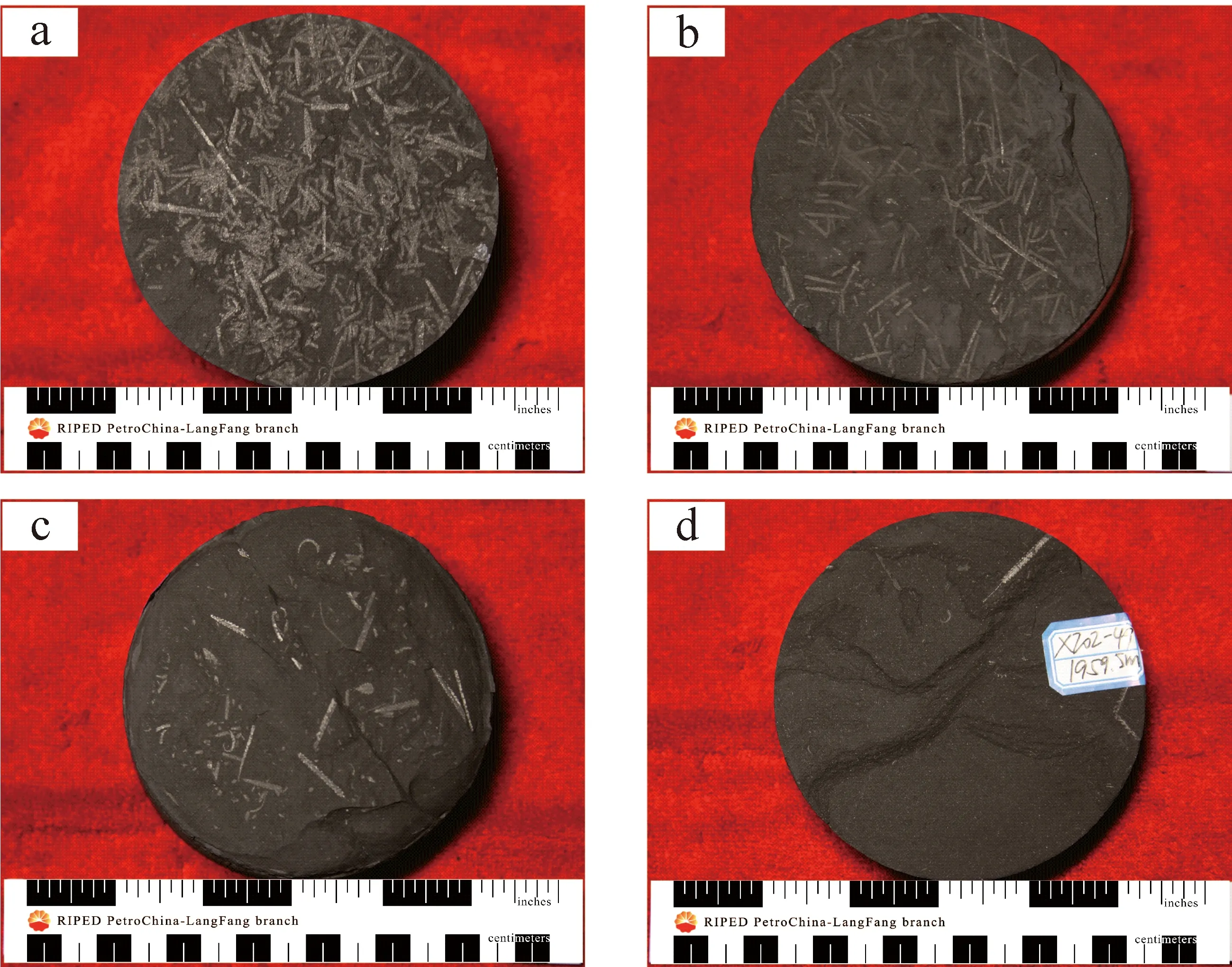
图3 五峰组—龙马溪组底部页岩及笔石丰度 a.样品笔石丰度45%,TOC=3.9%;b.样品笔石丰度30%,TOC=4.8%;c.样品笔石丰度15%,TOC=4.7%;d.样品笔石丰度5%,TOC=4.4%Fig.3 Graptolite abundance (GA) in the Wufeng and Longmaxi shalesa. GA=45%, TOC=3.9%; b. GA=30%, TOC=4.8%; c. GA=15%, TOC=4.7%; d. GA=5%, TOC=4.4%
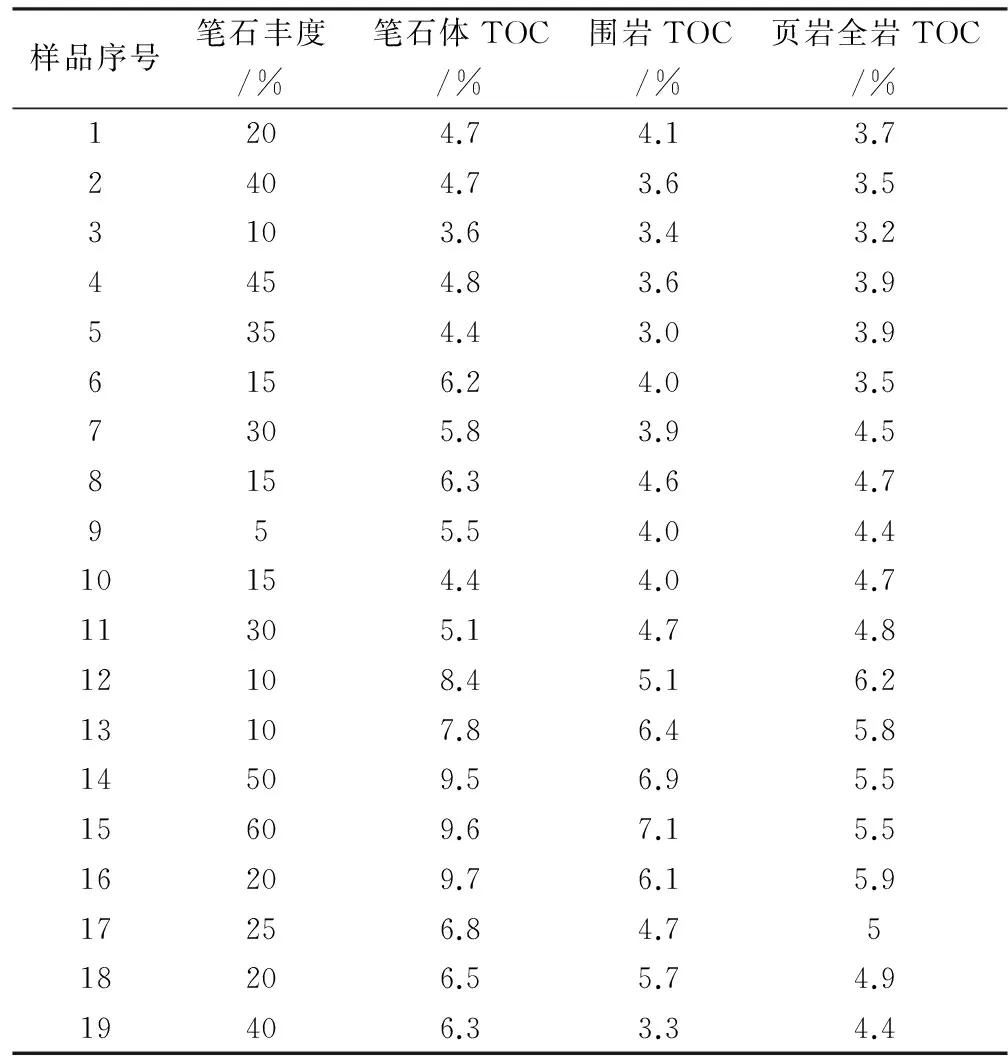
样品序号笔石丰度/%笔石体TOC/%围岩TOC/%页岩全岩TOC/%1204.74.13.72404.73.63.53103.63.43.24454.83.63.95354.43.03.96156.24.03.57305.83.94.58156.34.64.7955.54.04.410154.44.04.711305.14.74.812108.45.16.213107.86.45.814509.56.95.515609.67.15.516209.76.15.917256.84.7518206.55.74.919406.33.34.4
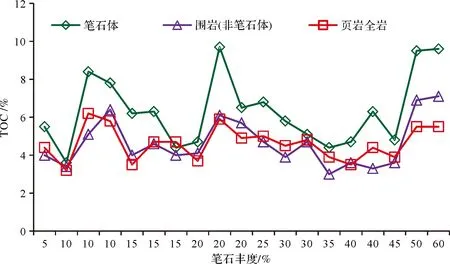
图4 五峰组—龙马溪组底部不同笔石丰度的页岩中笔石体、围岩及全岩的TOC变化Fig.4 TOC variations of graptolite, host shales and bulk rocks in the Wufeng and Longmaxi Formations
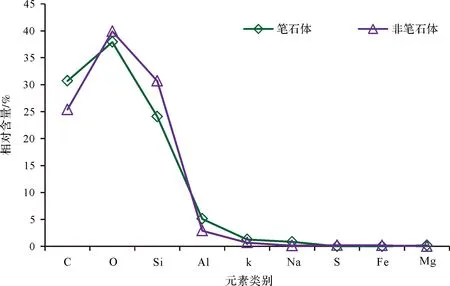
图5 五峰组—龙马溪组底部页岩笔石体及围岩元素分析Fig.5 Element distributions of graptolite and the host in the Wufeng and Longmaxi shales
已有学者提出五峰组—龙马溪组页岩中笔石丰度与TOC呈正相关关系[38]。然而,巫溪地区五峰组—龙马溪组底部页岩段中近400块页岩层面上的笔石丰度统计及TOC分析测试(图2,6)结果表明:页岩中笔石丰度与页岩TOC相关性较差(图6)。例如,笔石丰度为45%页岩(图3a)TOC为3.9%,明显低于笔石丰度为30%、15%和5%的页岩(图3b,c,d),它们TOC分别为4.8%、4.7%和4.4%。由于笔石是作为页岩宏观上唯一可识别的大化石类型,其保存方式多为沿页岩纹层面以叠加式或聚集式堆积,不同纹层面的笔石丰度变化较大(图2,3),这可能是造成其与页岩TOC相关性差的主要因素之一。
此外,19件不同笔石丰度与TOC的页岩样品中笔石体与围岩TOC的对比分析结果(图4)表明:①围岩TOC明显低于笔石体TOC,两者之间相关性较差,这说明页岩中笔石丰度对同沉积围岩TOC影响不大;②页岩全岩TOC与围岩的TOC相近,尽管两者之间相关性也相对较差,但在一定程度上说明页岩TOC受围岩影响较大。这是因为所开展笔石体和围岩TOC测试的样品均采自同一页岩层面,而页岩全岩TOC则是整个页岩样品(包括页岩层面)。由于页岩中沉积纹层物质组成具有一定差异,页岩全岩TOC并不是真正代表笔石页岩层(笔石体和围岩采集纹层)的TOC,故可能造成这两者相关性较差。
为了进一步客观评价页岩中笔石体、围岩及页岩全岩TOC之间关系,对8件不同笔石丰度的页岩样品开展同一层面上笔石体、围岩及全岩(即笔石体分布纹层,仅包括笔石体和围岩)TOC分析测试。结果表明(图7):①所有样品的笔石体TOC均明显高于围岩及页岩全岩的TOC,这与前述认识较一致(图4);②所有样品的笔石丰度与TOC相关性较差,这进一步说明笔石丰度与页岩中有机质富集关系不明显;③所有样品的围岩TOC与全岩相接近,且两者相关性较好,这也进一步说明了页岩全岩TOC主要受围岩TOC控制,指示着围岩中浮游藻类等浮游生物才是有机质富集的主要贡献者(图4)。

图6 五峰组—龙马溪组底部页岩笔石丰度与TOC关系Fig.6 Cross plot of graptolite abundance and TOC in the Wufeng and Longmaxi shales
笔石生物在五峰组—龙马溪组沉积时期分异度(多样性)及丰度相对较高[3,39],可以推测其赖以生存的食物链底层生物(藻类等)的多样性和丰度更大[3],但并不能指示着笔石与有机质富集关系密切。一方面,这是因为笔石生物大量存在会消费掉大量的浮游生物,减少了有机质的输出,不利于有机质的富集。此外,从图2中也可看出,笔石丰度向上整体是增加的,但有机质丰度是逐渐降低的。由于笔石生物为需氧呼吸型生物,这反应了水体的含氧度向上是逐渐增高的,这与沉积物颗粒向上逐渐变粗[10]趋势相吻合,这种情况显然不利于有机质的保存;同时,由于向上沉积速率逐渐增加[10],也会造成有机质的稀释。虽然笔石本身死亡后保存一部分有机质,但也不足以弥补这些有机质的损失。
有机质富集的控制因素一直存在着较大争论[50-55],其争论焦点是保存条件(水体氧化还原条件)和海洋表层生产力,到底哪个是有机质富集的主控因素。早期研究普遍认为缺氧的保存条件是富有机质沉积的主要控制因素[50,56-58]。然而,一些学者对洋流上涌地区(如秘鲁西部、非洲西北部、加利福尼亚以及南极洲北部等海域)的研究发现:由于富营养水体的上涌,表层生物极为繁盛说明其生物生产力较高,而海底沉积物中有机质含量很高但普遍见到生物扰动,表明底部水体并不缺氧,并由此推断高生产力才是富有机质沉积形成的主要控制因素[51]。这一认识也逐渐得到一些学者的认可,他们认为有机质富集沉积与海洋表层较高的(初级)生产力关系密切[59-62]。在五峰组—龙马溪组笔石页岩中有机质富集主控因素的研究方面,已有成果表明,缺氧保存条件是有机质富集的主控因素[10,24-30],而不是古生产力。但仅是作为有机质贡献者之一,而围岩中浮游藻类等才是有机质的主要贡献者(图7)。
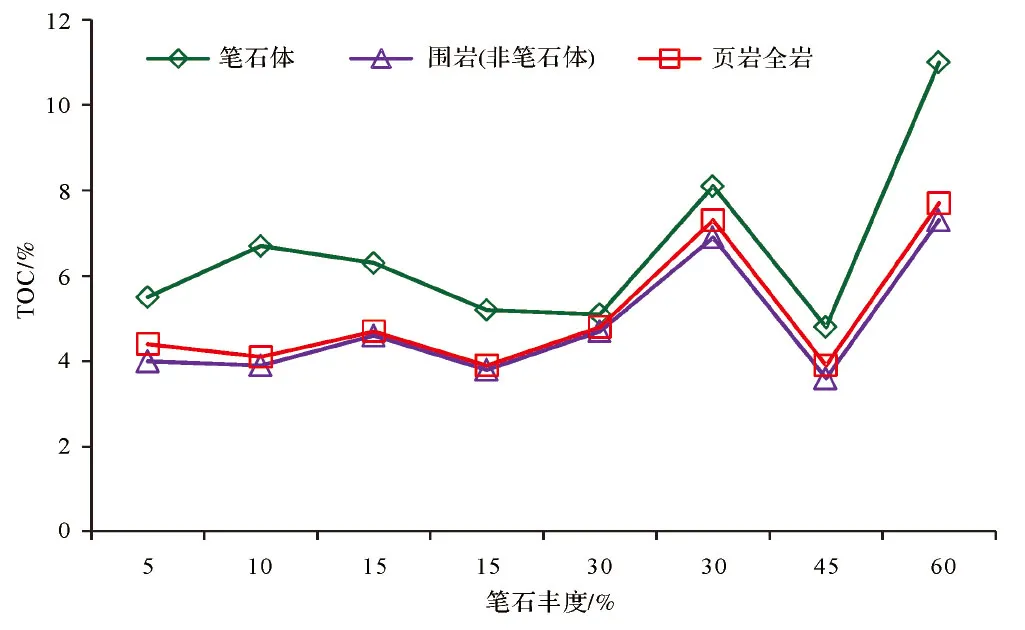
图7 五峰组—龙马溪组底部不同笔石丰度的页岩中笔石体、围岩及全岩的TOC变化Fig.7 TOC variations of graptolites, the host shales and bulk rocks with different graptolite abundances in the Wufeng and Longmaxi formations
综上所述,可以认为笔石虽然是页岩中有机质贡献者之一,但其丰度对页岩有机质富集影响较小。
4 笔石页岩有待深入研究的问题
刘大猛等[37]研究认为,笔石体主要是由含O、N等杂原子基团的高分子化合物的聚合物蛋白质组成,并认为其在成熟度较低时是一种极好的成烃母质。虽然本文研究认为笔石丰度对页岩有机质富集的影响较小,但这只是针对我国南方高成熟度的五峰组—龙马溪组页岩所取得的初步认识,该层系中笔石体反射率一般较高(2.68%~3.08%)[38]。因此,下一步可以开展未成熟—低成熟度页岩中笔石生烃方面的相关研究。
此外,五峰组—龙马溪组笔石页岩段是页岩气优质储集段,是目前我国页岩气勘探开发的目标层段。已有研究表明,笔石体具有粒状、纹层状的显微构造[63-64],显示网格状的内部结构[37],发育大量孔隙[39]。利用高分辨扫描电镜可识别出笔石体具有两类孔隙,即粒间孔隙(有机质与基质颗粒之间的孔隙)和有机质孔(生物结构孔隙和生物组织孔隙)[65]或体腔孔隙[66],大小从几十纳米到几微米[65]。这些均直观地揭示了笔石体对页岩气储层的储集能力有一定的贡献,但贡献大小如何有待深入研究。
5 结论
(1) 五峰组—龙马溪组页岩中笔石体C、O等元素含量较高,其TOC明显高于页岩全岩及围岩的TOC,是页岩有机质的贡献者之一。
(2) 五峰组—龙马溪组页岩全岩TOC与笔石丰度及笔石体TOC相关性均较差,而与围岩TOC相关性较好,这指示着页岩中笔石丰度对有机质富集影响较小。
(3) 笔石生烃及储集特征对页岩气有效勘探开发具有重要意义,是需要进一步研究的问题。
致谢 本文在撰写和研究中得到中国科学院陈旭院士、中国石油勘探开发研究院邹才能教授的指导和帮助。同时感谢中国石油勘探开发研究院廊坊分院拜文华、赵群、梁峰、郭伟、薛华庆及中国石油勘探开发研究院王玉满、李新景等诸同事的支持与帮助。特别感谢特邀主编陈代钊研究员提出的宝贵修改意见。
References)
1 Chen Xu, Rong Jiayu, Li Yue, et al. Facies patterns and geography of the Yangtze region, South China, through the Ordovician and Silurian transition[J]. Palaeogeography, Palaeoclimatology, Palaeoecology, 2004, 204(3/4): 353-372.
2 樊隽轩,Melchin M J,陈旭,等. 华南奥陶—志留系龙马溪组黑色笔石页岩的生物地层学[J]. 中国科学(D辑):地球科学,2012,42(1):130-139. [Fan Junxuan, Melchin M J, Chen Xu, et al. Biostratigraphy and geography of the Ordovician-Silurian Lungmachi black shales in South China[J]. Science China(Seri,D): Earth Sciences, 2012, 42(1): 130-139.]
3 陈旭,樊隽轩,张元动,等. 五峰组及龙马溪组黑色页岩在扬子覆盖区内的划分与圈定[J]. 地层学杂志,2015,39(4):351-358. [Chen Xu, Fan Junxuan, Zhang Yuandong, et al. Subdivision and delineation of the Wufeng and Lungmachi black shales in the subsurface areas of the Yangtze Platform[J]. Journal of Stratigraphy, 2015, 39(4): 351-358.]
4 王世谦,陈更生,董大忠,等,等. 四川盆地下古生界页岩气藏形成条件与勘探前景[J]. 天然气工业,2009,29(5):51-58. [Wang Shiqian, Chen Gengsheng, Dong Dazhong, et al. Accumulation conditions and exploitation prospect of shale gas in the Lower Paleozoic Sichuan basin[J]. Natural Gas Industry, 2009, 29(5): 51-58.]
5 邹才能,董大忠,王社教,等. 中国页岩气形成机理、地质特征及资源潜力[J]. 石油勘探与开发,2010,37(6):641-653. [Zou Caineng, Dong Dazhong, Wang Shejiao, et al. Geological characteristics, formation mechanism and resource potential of shale gas in China[J]. Petroleum Exploration and Development, 2010, 37(6): 641-653.]
6 董大忠,邹才能,杨桦,等. 中国页岩气勘探开发进展与发展前景[J]. 石油学报,2012,33(S1):107-114. [Dong Dazhong, Zou Caineng, Yang Hua, et al. Progress and prospects of shale gas exploration and development in China[J]. Acta Petrolei Sinica, 2012, 33(S1): 107-114.]
7 郭旭升,郭彤楼,魏志红,等. 中国南方页岩气勘探评价的几点思考[J]. 中国工程科学,2012,14(6):101-105. [Guo Xusheng, Guo Tonglou, Wei Zhihong, et al. Thoughts on shale gas exploration in southern China[J]. Engineering Sciences, 2012, 14(6): 101-105.]
8 郭彤楼,刘若冰. 复杂构造区高演化程度海相页岩气勘探突破的启示——以四川盆地东部盆缘JY1井为例[J]. 天然气地球科学,2013,24(4):643-651. [Guo Tonglou, Liu Ruobing. Implications from marine shale gas exploration breakthrough in complicated structural area at high thermal stage: Taking Longmaxi Formation in well JY1 as an example[J]. Natural Gas Geoscience, 2013, 24(4): 643-651.]
9 郭旭升. 南方海相页岩气"二元富集"规律—四川盆地及周缘龙马溪组页岩气勘探实践认识[J]. 地质学报,2014,88(7):1209-1218. [Guo Xusheng. Rules of two-factor enrichiment for marine shale gas in southern China—Understanding from the Longmaxi Formation shale gas in Sichuan Basin and its surrounding area[J]. Acta Geologica Sinica, 2014, 88(7): 1209-1218.]
10 邹才能,董大忠,王玉满,等. 中国页岩气特征、挑战及前景(一)[J]. 石油勘探与开发,2015,42(6):689-701. [Zou Caineng, Dong Dazhong, Wang Yuman, et al. Shale gas in China: characteristics, challenges and prospects (Ⅰ)[J]. Petroleum Exploration and Development, 2015, 42(6): 689-701.]
11 董大忠,王玉满,李新景,等. 中国页岩气勘探开发新突破及发展前景思考[J]. 天然气工业,2016,36(1):19-32. [Dong Dazhong, Wang Yuman, Li Xinjing, et al. Breakthrough and prospect of shale gas exploration and development in China[J]. Natural Gas Industry, 2016, 36(1): 19-32.]
12 何治亮,聂海宽,张钰莹. 四川盆地及其周缘奥陶系五峰组—志留系龙马溪组页岩气富集主控因素分析[J]. 地学前缘,2016,23(2):8-17. [He Zhiliang, Nie Haikuan, Zhang Yuying. The main factors of shale gas enrichment of Ordovician Wufeng Formation-Silurian Longmaxi Formation in the Sichuan Basin and its adjacent areas[J]. Earth Science Frontiers, 2016, 23(2): 8-17.]
13 金之钧,胡宗全,高波,等. 川东南地区五峰组—龙马溪组页岩气富集与高产控制因素[J]. 地学前缘,2016,23(1):1-10. [Jin Zhijun, Hu Zongquan, Gao Bo, et al. Controlling factors on the enrichment and high productivity of shale gas in the Wufeng-Longmaxi Formations, southeastern Sichuan Basin[J]. Earth Science Frontiers, 2016, 23(1): 1-10.]
14 陈旭,戎嘉余,樊隽轩,等. 奥陶—志留系界线地层生物带的全球对比[J]. 古生物学报,2000,39(1):100-114. [Chen Xu, Rong Jiayu, Fan Junxuan, et al. A global correlation of biozones across the Ordovician-Silurian boundary[J]. Acta Palaeontologica Sinica, 2000, 39(1): 100-114.]
15 Chen Xu, Rong Jjiayu, Fan Junxuan, et al. The global boundary stratotype section and point (GSSP) for the base of the Hirnantian Stage (the uppermost of the Ordovician System)[J]. Episodes, 2006, 29(3): 183-196.
16 戎嘉余,陈旭,詹仁斌,等. 贵州桐梓县境南部奥陶系—志留系界线地层新认识[J]. 地层学杂志,2010,34(4):337-348. [Rong Jiayu, Chen Xu, Zhan Renbin, et al. New observation on Ordovician-Silurian boundary strata of southern Tongzi county, northern Guizhou, southwest China[J]. Journal of Stratigraphy, 2010, 34(4): 337-348.]
17 梁超,姜在兴,杨镱婷,等. 四川盆地五峰组—龙马溪组页岩岩相及储集空间特征[J]. 石油勘探与开发,2012,39(6):691-698. [Liang Chao, Jiang Zaixing, Yang Yiting, et al. Characteristics of shale lithofacies and reservoir space of the Wufeng-Longmaxi Formation, Sichuan Basin[J]. Petroleum Exploration and Development, 2012, 39(6): 691-698.]
18 王玉满,王淑芳,董大忠,等. 川南下志留统龙马溪组页岩岩相表征[J]. 地学前缘,2016,23(1):119-133. [Wang Yuman, Wang Shufang, Dong Dazhong, et al. Lithofacies characterization of Longmaxi Formation of the Lower Silurian, southern Sichuan[J]. Earth Science Frontiers, 2016, 23(1): 119-133.]
19 蒋裕强,宋益滔,漆麟,等. 中国海相页岩岩相精细划分及测井预测:以四川盆地南部威远地区龙马溪组为例[J]. 地学前缘,2016,23(1):107-118. [Jiang Yuqiang, Song Yitao, Qi Lin, et al. Fine lithofacies of China's marine shale and its logging prediction: A case study of the Lower Silurian Longmaxi marine shale in Weiyuan area, southern Sichuan Basin, China[J]. Earth Science Frontiers, 2016, 23(1): 107-118.]
20 王玉满,董大忠,李建忠,等. 川南下志留统龙马溪组页岩气储层特征[J]. 石油学报,2012,33(4):551-561. [Wang Yuman, Dong Dazhong, Li Jianzhong, et al. Reservoir characteristics of shale gas in Longmaxi Formation of the Lower Silurian, southern Sichuan[J]. Acta Petrolei Sinica, 2012, 33(4): 551-561.]
21 刘树根,王世玉,孙玮,等. 四川盆地及其周缘五峰组—龙马溪组黑色页岩特征[J]. 成都理工大学学报:自然科学版,2013,40(6):621-639. [Liu Shugen, Wang Shiyu, Sun Wei, et al. Characteristics of black shale in Wufeng Formation and Longmaxi Formation in Sichuan Basin and its peripheral areas[J]. Journal of Chengdu University of Technology: Science & Technology Edition, 2013, 40(6): 621-639.]
22 蒲泊伶,董大忠,吴松涛,等. 川南地区下古生界海相页岩微观储集空间类型[J]. 中国石油大学学报:自然科学版,2014,38(4):19-25. [Pu Boling, Dong Dazhong, Wu Songtao, et al. Microscopic space types of Lower Paleozoic marine shale in southern Sichuan Basin[J]. Journal of China University of Petroleum: Edition of Natural Science, 2014, 38(4): 19-25.]
23 Yang Feng, Ning Zhengfu, Wang Qing, et al. Pore structure characteristics of lower Silurian shales in the southern Sichuan Basin, China: insights to pore development and gas storage mechanism[J]. International Journal of Coal Geology, 2016, 156: 12-24.
24 李双建,肖开华,沃玉进,等. 南方海相上奥陶统——下志留统优质烃源岩发育的控制因素[J]. 沉积学报,2008,26(5):872-880. [Li Shuangjian, Xiao Kaihua, Wo Yujin, et al. Developmental controlling factors of Upper Ordovician-Lower Silurian high quality source rocks in marine sequence, South China[J]. Acta Sedimentologica Sinica, 2008, 26(5): 872-880.]
25 李双建,肖开华,沃玉进,等. 中上扬子地区上奥陶统—下志留统烃源岩发育的古环境恢复[J]. 岩石矿物学杂志,2009,28(5):450-458. [Li Shuangjian, Xiao Kaihua, Wo Yujin, et al. Palaeo-environment restoration of Upper Ordovician-Lower Silurian hydrocarbon source rock in Middle-Upper Yangtze area[J]. Acta Petrologica et Mineralogica, 2009, 28(5): 450-458.]
26 Yan Detian, Chen Daizhen, Wang Qingchen, et al. Predominance of stratified anoxic Yangtze Sea interrupted by short-term oxygenation during the Ordo-Silurian transition[J]. Chemical Geology, 2012, 291: 69-78.
27 张春明,姜在兴,郭英海,等. 川东南—黔北地区龙马溪组地球化学特征与古环境恢复[J]. 地质科技情报,2013,32(2):124-130. [Zhang Chunming, Jiang Zaixing, Guo Yinghai, et al. Geochemical characteristics and paleoenvironment reconstruction of the Longmaxi Formation in Southeast Sichuan and northern Guizhou[J]. Geological Science and Technology Information, 2013, 32(2): 124-130.]
28 王淑芳,董大忠,王玉满,等. 四川盆地南部志留系龙马溪组富有机质页岩沉积环境的元素地球化学判别指标[J]. 海相油气地质,2014,19(3):27-34. [Wang Shufang, Dong Dazhong, Wang Yuman, et al. Geochemistry evaluation index of redox-sensitive elements for depositional environments of Silurian Longmaxi organic-rich Shale in the South of Sichuan Basin[J]. Marine Origin Petroleum Geology, 2014, 19(3): 27-34.]
29 李艳芳,邵德勇,吕海刚,等. 四川盆地五峰组—龙马溪组海相页岩元素地球化学特征与有机质富集的关系[J]. 石油学报,2015,36(12):1470-1483. [Li Yanfang, Shao Deyong, Lv Haigang, et al. A relationship between elemental geochemical characteristics and organic matter enrichment in marine shale of Wufeng Formation-Longmaxi Formation, Sichuan Basin[J]. Acta Petrolei Sinica, 2015, 36(12): 1470-1483.]
30 严德天,王清晨,陈代钊,等. 扬子及周缘地区上奥陶统—下志留统烃源岩发育环境及其控制因素[J]. 地质学报,2008,82(3):322-327. [Yan Detian, Wang Qingchen, Chen Daizhao, et al. Sedimentary environment and development controls of the hydrocarbon sources beds: the Upper Ordovician Wufeng Formation and the Lower Silurian Longmaxi Formation in the Yangtze Area[J]. Acta Geologica Sinica, 2008, 82(3): 322-327.]
31 Riediger C, Goodarzi F, Macqueen R W. Graptolites as indicators of regional maturity in Lower Paleozoic sediments, Selwyn Basin, Yukon and Northwest Territories, Canada[J]. Canadian Journal of Earth Sciences, 1989, 26(10): 2003-2015.
32 穆恩之,李积金. 笔石[M]. 北京:科学出版社,1960. [Mu Enzhi, Li Jijin. Graptolite[M]. Beijing: Science Press, 1960.]
33 Kozlowski R. On the structure and relationships of graptolites[J]. Journal of Paleontology, 1966, 40(3): 489-501.
34 Combaz A. Les kérogènes vus au microscope[M]//Durand B. Kerogen: Insoluble Organic Matter from Sedimentary Rocks. Paris: Editions Techniq, 1980: 35-62.
35 Towe K M, Urbanek A. Collagen-like structures in Ordovician graptolite periderm[J]. Nature, 1972, 237(5356): 443-445.
36 张永辂,刘冠邦,边立曾. 古生物学:上册[M]. 北京:地质出版社,1988:343. [Zhang Yonglu, Liu Guanbang, Bian Lizeng. Paleobiology: Upper Part[M]. Beijing: Geological Publishing House, 1988: 343.]
37 刘大锰,侯孝强,蒋金鹏. 笔石组成与结构的微区分析[J]. 矿物学报,1996,16(1):53-57. [Liu Dameng, Hou Xiaoqiang, Jiang Jinpeng. The composition and structure of graptolite—a micro-area analysis[J]. Acta Mineralogica Sinica, 1996, 16(1): 53-57.]
38 马施民,邹晓艳,朱炎铭,等. 川南龙马溪组笔石类生物与页岩气成因相关性研究[J]. 煤炭科学技术,2015,43(4):106-109. [Ma Shimin, Zou Xiaoyan, Zhu Yanming, et al. Study on relationship between graptolite and shale gas origin of Longmaxi Formation in southern Sichuan[J]. Coal Science and Technology, 2015, 43(4): 106-109.]
39 Luo Qingyong, Zhong Ningning, Dai Na, et al. Graptolite-derived organic matter in the Wufeng-Longmaxi Formations (Upper Ordovician-Lower Silurian) of southeastern Chongqing, China: implications for gas shale evaluation[J]. International Journal of Coal Geology, 2016, 153: 87-98.
40 李志明,全秋琦. 中国南部奥陶—志留纪笔石页岩相类型及其构造古地理[J]. 地球科学,1992,17(3):261-269. [Li Zhiming, Quan Qiuqi. Lithofacies types and tectonic palaeo-geography of Ordovician and Silurian graptolite-bearing strata in south China[J]. Earth Science, 1992, 17(3): 261-269.]
41 张元动,陈旭,Goldman D,等. 华南早—中奥陶世主要环境下笔石动物的多样性与生物地理分布[J]. 中国科学(D辑):地球科学,2010,40(9):1164-1180. [Zhang Yuandong, Chen Xu, Goldman D, et al. Diversity and paleobiogeographic distribution patterns of Early and Middle Ordovician graptolites in distinct depositional environments of South China[J]. Science China (Seri.D): Earth Sciences, 2010, 40(9): 1164-1180.]
42 戎嘉余,陈旭,王怿,等. 奥陶—志留纪之交黔中古陆的变迁:证据与启示[J]. 中国科学:地球科学,2011,41(10):1407-1415. [Rong Jiayu, Chen Xu, Wang Yi, et al. Northward expansion of Central Guizhou Oldland through the Ordovician and Silurian transition: evidence and implications[J]. Scientia Sinica Terrae, 2011, 41(10): 1407-1415.]
43 李志明,戴维声. 志留系[M]//王鸿祯. 中国古地理图集. 北京:地图出版社,1985:47-55. [Li Zhiming, Dai Weisheng. Siliurian[M]//Wang Hongzhen. Atlas of the Palaeogeography of China. Beijing: Map Press, 1985: 47-55.]
44 梁峰,拜文华,邹才能,等. 渝东北地区巫溪2井页岩气富集模式及勘探意义[J]. 石油勘探与开发,2016,43(3):350-358. [Liang Feng, Bai Wenhua, Zou Caineng, et al. Shale gas enrichment pattern and exploration significance of Well Wuxi-2 in northeast Chongqing, NE Sichuan Basin[J]. Petroleum Exploration and Development, 2016, 43(3): 350-358.]
45 龙鹏宇,张金川,李玉喜,等. 重庆及其周缘地区下古生界页岩气成藏条件及有利区预测[J]. 地学前缘,2012,19(2):221-233. [Long Pengyu, Zhang Jinchuan, Li Yuxi, et al. Reservoir-forming conditions and favorable area of shale gas in the Lower Paleozoic of Chongqing and its adjacent areas[J]. Earth Science Frontiers, 2012, 19(2): 221-233.]
46 张志平,程礼军,曾春林,等. 渝东北志留系下统龙马溪组页岩气成藏地质条件研究[J]. 特种油气藏,2012,19(4):25-28. [Zhang Zhiping, Cheng Lijun, Zeng Chunlin, et al. Geological study on shale gas reservoirs in the Longmaxi Formation of Lower Silurian in northeast Chongqing[J]. Special Oil and Gas Reservoirs, 2012, 19(4): 25-28.]
47 Rantitsch G. Coalification and graphitization of graptolites in the anchizone and lower epizone[J]. International Journal of Coal Geology, 1995, 27(1): 1-22.
49 Petersen H I, Schovsbo N H, Nielsen A T. Reflectance measurements of zooclasts and solid bitumen in Lower Paleozoic shales, southern Scandinavia: correlation to vitrinite reflectance[J]. International Journal of Coal Geology, 2013, 114: 1-18.
50 Demaison G J, Moore G T. Anoxic environments and oil source bed genesis[J]. AAPG Bulletin, 1980, 64: 1179-1209.
51 Pedersen T F, Calvert S E. Anoxia vs. productivity: what controls the formation of organic-carbon-rich sediments and sedimentary rocks?[J]. AAPG Bulletin, 1990, 74(4): 454-466.
52 Calvert S E, Pedersen T F. Geochemistry of recent oxic and anoxic marine sediments: implications for the geological record[J]. Marine Geology, 1993, 113(1/2): 67-88.
53 Murphy A E, Sageman B B, Hollander D J, et al. Black shale deposition and faunal overturn in the Devonian Appalachian Basin: clastic starvation, seasonal water-column mixing, and efficient biolimiting nutrient recycling[J]. Paleoceanography, 2000, 15(3): 280-291.
54 Pichevin L, Bertrand P, Boussafir M, et al. Organic matter accumulation and preservation controls in a deep sea modern environment: an example from Namibian slope sediments[J]. Organic Geochemistry, 2004, 35(5): 543-559.
55 Mort H, Jacquat O, Adatte T, et al. The Cenomanian/Turonian anoxic event at the Bonarelli Level in Italy and Spain: enhanced productivity and/or better preservation?[J]. Cretaceous Research, 2007, 28(4): 597-612.
56 Ingall E D, Bustin R M, Van Cappellen P. Influence of water column anoxia on the burial and preservation of carbon and phosphorus in marine shales[J]. Geochimica et Cosmochimica Acta, 1993, 57(2): 303-316.
57 Arthur M A, Sageman B B. Marine black shales: depositional mechanisms and environments of ancient deposits[J]. Annual Review of Earth and Planetary Sciences, 1994, 22: 499-551.
58 Rimmer S M. Geochemical paleoredox indicators in Devonian-Mississippian black shales, Central Appalachian Basin (USA)[J]. Chemical Geology, 2004, 206(3/4): 373-391.
59 Caplan M L, Bustin R M. Palaeoceanographic controls on geochemical characteristics of organic-rich Exshaw mudrocks: role of enhanced primary production[J]. Organic Geochemistry, 1998, 30(2/3): 161-188.
60 Sageman B B, Murphy A E, Werne J P, et al. A tale of shales: the relative roles of production, decomposition, and dilution in the accumulation of organic-rich strata, Middle-Upper Devonian, Appalachian basin[J]. Chemical Geology, 2003, 195(1/2/3/4): 229-273.
61 Gallego-Torres D, Martínez-Ruiz F, Paytan A, et al. Pliocene-Holocene evolution of depositional conditions in the eastern Mediterranean: role of anoxia vs. productivity at time of sapropel deposition[J]. Palaeogeography, Palaeoclimatology, Palaeoecology, 2007, 246(2/3/4): 424-439.
62 Wei H Y, Chen D Z, Wang J G, et al. Organic accumulation in the lower Chihsia Formation (Middle Permian) of South China: constraints from pyrite morphology and multiple geochemical proxies[J]. Palaeogeography, Palaeoclimatology, Palaeoecology, 2012, 353-355: 73-86.
63 陈旭,钱泽书. 苏北兰多维列世笔石孤立标本的研究[J]. 古生物学报,1990,29(1):1-11. [Chen Xu, Qian Zeshu. Isolated llandovery graptolites from northern Jiangsu[J]. Acta Palaeontologica Sinica, 1990, 29(1): 1-11.]
64 Bates D E B, Kirk N H, Loydell D. Ultrastructural studies on graptolites using scanning electron microscope[J]. Acta Palaeontologica Sinica, 1988, 27(5): 536-541.
65 戴娜,钟宁宁,张瑜,等. 氩离子抛光/扫描电镜分析方法在笔石有机质研究中的应用[J]. 电子显微学报,2015,34(5):416-420. [Dai Na, Zhong Ningning, Zhang Yu, et al. Ar ion milling/SEM analysis on graptolitinite macerals[J]. Journal of Chinese Electron Microscopy Society, 2015, 34(5): 416-420.]
66 邓昆,周文,周立发,等. 鄂尔多斯盆地奥陶系平凉组笔石页岩微孔隙特征及其影响因素[J]. 石油勘探与开发,2016,43(3):378-385. [Deng Kun, Zhou Wen, Zhou Lifa, et al. Influencing factors of micropores in the graptolite shale of Ordovician Pingliang Formation in Ordos Basin, China[J]. Petroleum Exploration and Development, 2016, 43(3): 378-385.]
Discussion on the Relationship between Graptolite Abundance and Organic Enrichment in Shales from the Wufeng and Longmaxi Formation, South China
QIU Zhen1,2DONG DaZhong1,2LU Bin2ZHOU Jie2SHI ZhenSheng2WANG HongYan2LIN Wen2ZHANG ChenChen1LIU DeXun2
(1. Research Institute of Petroleum Exploration and Development, PetroChina, Beijing 100083, China; 2. Langfang Branch, PetroChina Exploration and Development Research Institute, Langfang, Hebei 065007, China)
The graptolitic shales of the Wufeng and Longmaxi Formations were widely deposited across the Ordovician and Silurian transition in South China. Based on the statistics of graptolite abundance from nearly 400 shale samples and total organic content (TOC) from nearly 100 shale samples in the Ordovician-Silurian boundary succession in Wuxi area of Chongqing, 23 shale samples have been further selected to determine the contribution of the graptolite abundance to overall TOC. The energy spectrum analysis showed the C and O contents in the graptolites are higher than those in the host of Wufeng and Longmaxi shales, and the TOC of the graptolite is apparently higher than that of the surrounding host, showing the graptolite might be one of the contributors of organic matter in the shale. However, the overall TOC in shales generally has a poor correlation with the graptolite abundance in shales, implying that the graptolite abundance in shales has not a great impact on the organic enrichment.
graptolite; shale gas; Wufeng Formation; Longmaxi Formation; organic enrichment; Wuxi area
1000-0550(2016)06-1011-10
10.14027/j.cnki.cjxb.2016.06.001
2016-05-20; 收修改稿日期: 2016-08-22
国家自然基金项目(41602119);国家重点基础研究发展计划(973计划)项目(2013CB228001)[Foundation: National Natural Science Foundation, No. 41602119; National Key Basic Research Program of China (973 Program), No. 2013CB228001]
邱 振 男 1984年出生 工程师 沉积学与非常规油气地质学 E-mail: qiuzhen316@163.com
P618.13
A
